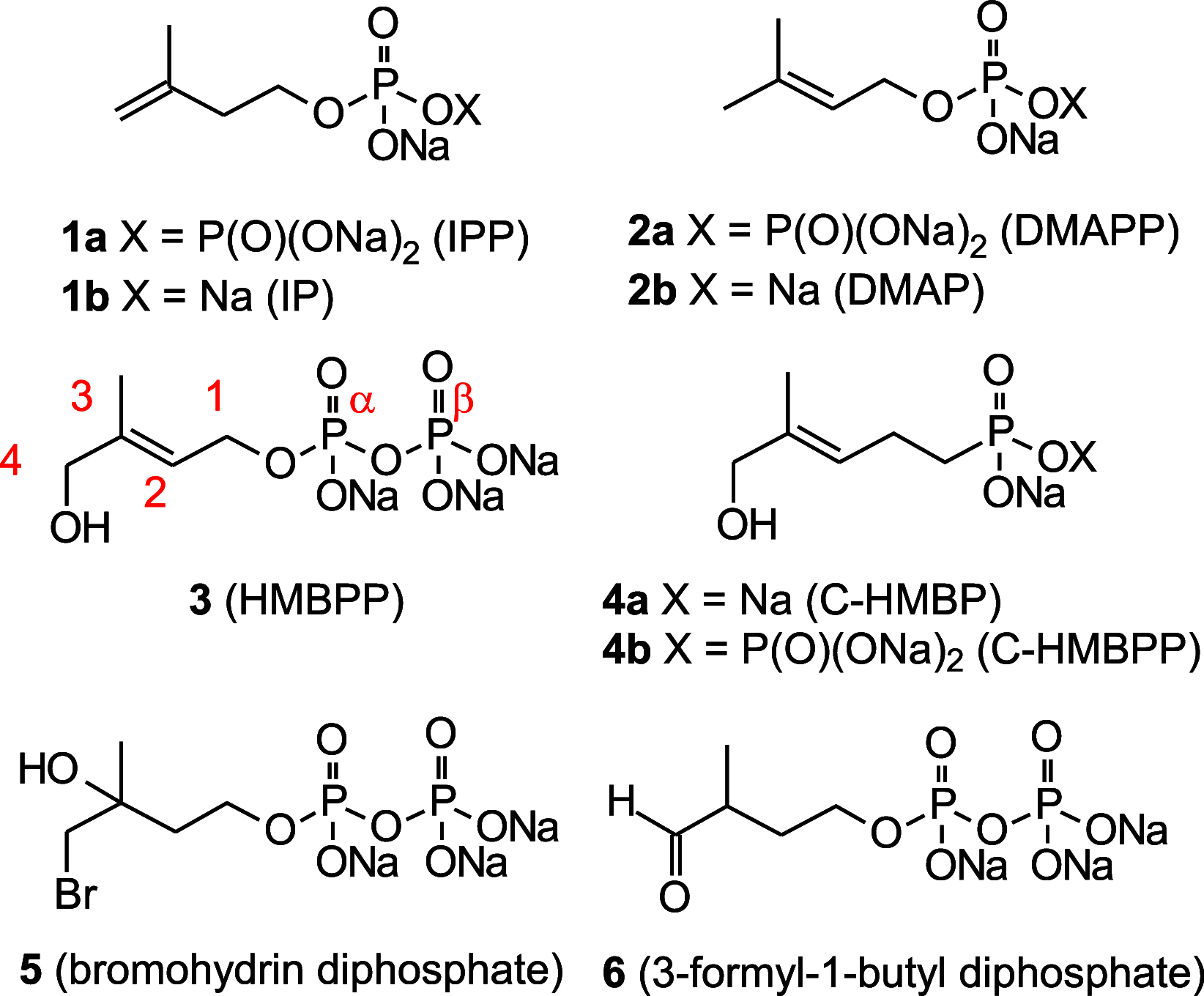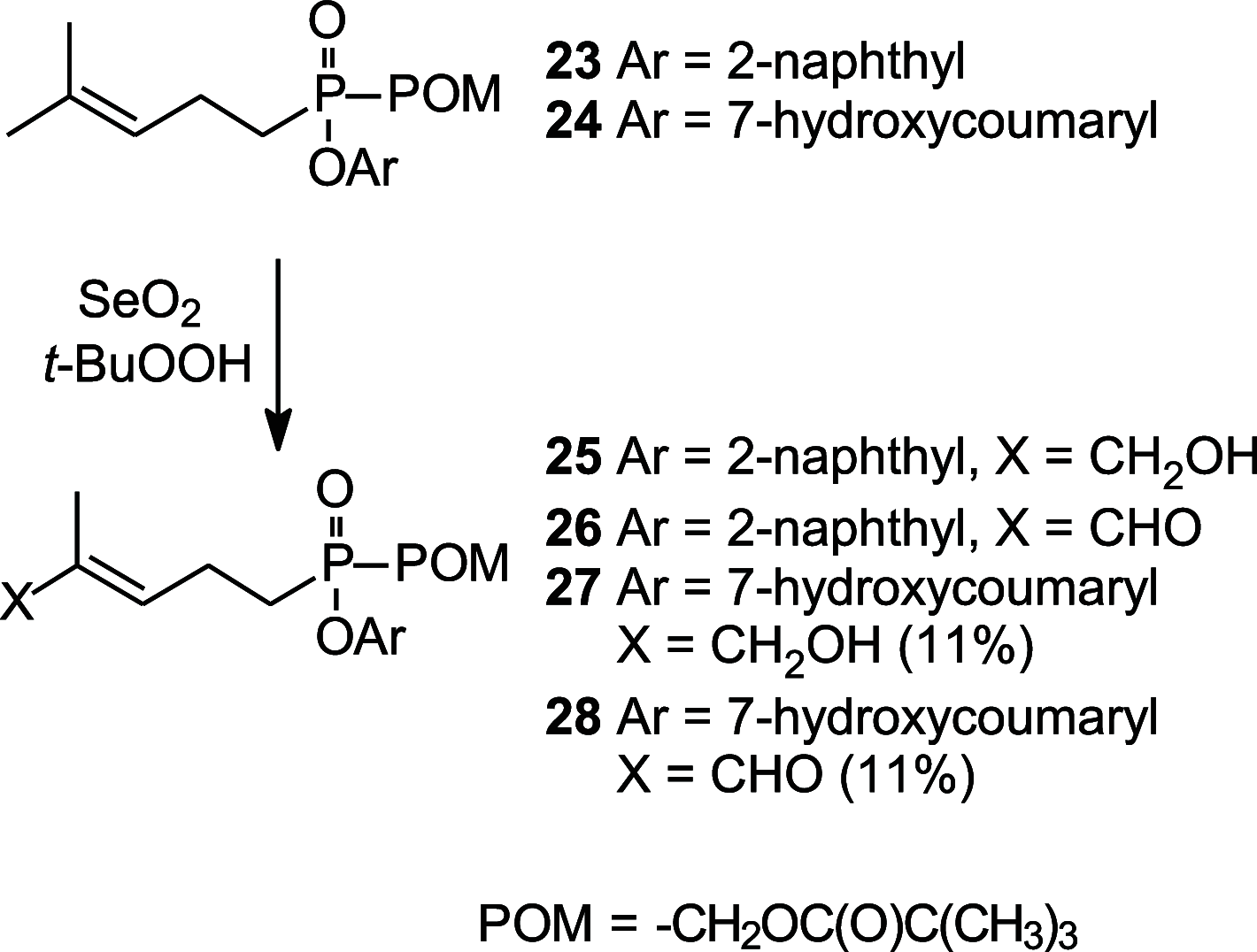Synthesis and Metabolism of BTN3A1 Ligands: Studies on Modifications of the Allylic Alcohol
- PMID: 33488975
- PMCID: PMC7812676
- DOI: 10.1021/acsmedchemlett.0c00586
Synthesis and Metabolism of BTN3A1 Ligands: Studies on Modifications of the Allylic Alcohol
Abstract
(E)-4-Hydroxy-3-methyl-but-2-enyl diphosphate (HMBPP) and its phosphonate analogs are potent phosphoantigens. HMBPP contains an (E)-allylic alcohol which interacts with the molecular target BTN3A1 giving an antigenic signal to activate Vγ9Vδ2 T cells. As probes of BTN3A1 function, we prepared prodrug derivatives of the HMBPP analog C-HMBP that lack the (E)-allylic alcohol or have modified it to an aldehyde or aldoxime and evaluated their biological activity. Removal of the alcohol completely abrogates phosphoantigenicity in these compounds while the aldoxime modification decreases potency relative to the (E)-allylic alcohol form. However, homoprenyl derivatives oxidized to an aldehyde stimulate Vγ9Vδ2 T cells at nanomolar concentrations. Selection of phosphonate protecting groups (i.e., prodrug forms) impacts the potency of phosphoantigen aldehydes, with mixed aryl acyloxyalkyl forms exhibiting superior activity relative to aryl amidate forms. The activity correlates with the cellular reduction of the aldehyde to the alcohol form. Thus, the functionality on this ligand framework can be altered concurrently with phosphonate protection to promote cellular transformation to highly potent phosphoantigens.
© 2020 American Chemical Society.
Conflict of interest statement
The authors declare the following competing financial interest(s): A.J.W. and D.F.W. own shares in Terpenoid Therapeutics, Inc. The current work did not involve the company. The other authors have no financial conflicts of interest.
Figures








Similar articles
-
Synthesis and Metabolism of BTN3A1 Ligands: Studies on Diene Modifications to the Phosphoantigen Scaffold.ACS Med Chem Lett. 2022 Jan 27;13(2):164-170. doi: 10.1021/acsmedchemlett.1c00408. eCollection 2022 Feb 10. ACS Med Chem Lett. 2022. PMID: 35178171 Free PMC article.
-
A Photo-Crosslinkable Biotin Derivative of the Phosphoantigen (E)-4-Hydroxy-3-Methylbut-2-Enyl Diphosphate (HMBPP) Activates Vγ9Vδ2 T Cells and Binds to the HMBPP Site of BTN3A1.Chemistry. 2017 Sep 4;23(49):11945-11954. doi: 10.1002/chem.201702650. Epub 2017 Aug 10. Chemistry. 2017. PMID: 28631855
-
Diester Prodrugs of a Phosphonate Butyrophilin Ligand Display Improved Cell Potency, Plasma Stability, and Payload Internalization.J Med Chem. 2023 Nov 23;66(22):15309-15325. doi: 10.1021/acs.jmedchem.3c01358. Epub 2023 Nov 7. J Med Chem. 2023. PMID: 37934915 Free PMC article.
-
The Vγ9Vδ2 T Cell Antigen Receptor and Butyrophilin-3 A1: Models of Interaction, the Possibility of Co-Evolution, and the Case of Dendritic Epidermal T Cells.Front Immunol. 2014 Dec 19;5:648. doi: 10.3389/fimmu.2014.00648. eCollection 2014. Front Immunol. 2014. PMID: 25566259 Free PMC article. Review.
-
ABCA1, apoA-I, and BTN3A1: A Legitimate Ménage à Trois in Dendritic Cells.Front Immunol. 2018 Jun 8;9:1246. doi: 10.3389/fimmu.2018.01246. eCollection 2018. Front Immunol. 2018. PMID: 29937767 Free PMC article. Review.
Cited by
-
Synthesis and Metabolism of BTN3A1 Ligands: Studies on Diene Modifications to the Phosphoantigen Scaffold.ACS Med Chem Lett. 2022 Jan 27;13(2):164-170. doi: 10.1021/acsmedchemlett.1c00408. eCollection 2022 Feb 10. ACS Med Chem Lett. 2022. PMID: 35178171 Free PMC article.
-
Efficiency of bis-amidate phosphonate prodrugs.Bioorg Med Chem Lett. 2022 Jun 15;66:128724. doi: 10.1016/j.bmcl.2022.128724. Epub 2022 Apr 8. Bioorg Med Chem Lett. 2022. PMID: 35405283 Free PMC article.
-
The Multifaceted MEP Pathway: Towards New Therapeutic Perspectives.Molecules. 2023 Feb 1;28(3):1403. doi: 10.3390/molecules28031403. Molecules. 2023. PMID: 36771066 Free PMC article. Review.
References
-
- Morita C. T.; Jin C.; Sarikonda G.; Wang H. Nonpeptide antigens, presentation mechanisms, and immunological memory of human Vgamma2Vdelta2 T cells: discriminating friend from foe through the recognition of prenyl pyrophosphate antigens. Immunol. Rev. 2007, 215, 59–76. 10.1111/j.1600-065X.2006.00479.x. - DOI - PubMed
Grants and funding
LinkOut - more resources
Full Text Sources
Other Literature Sources
Chemical Information
Research Materials

